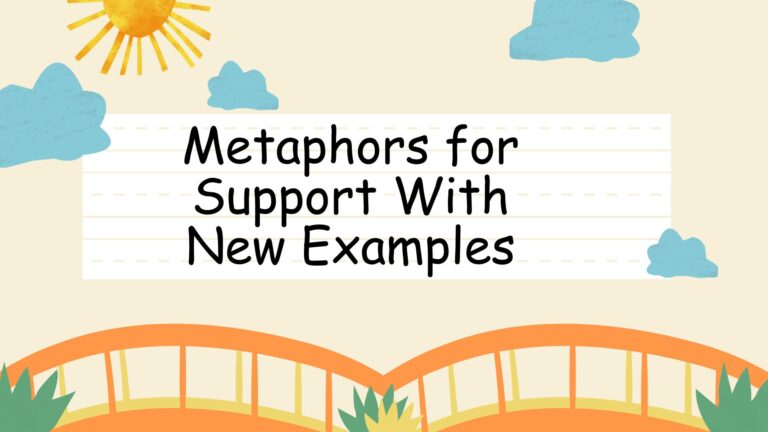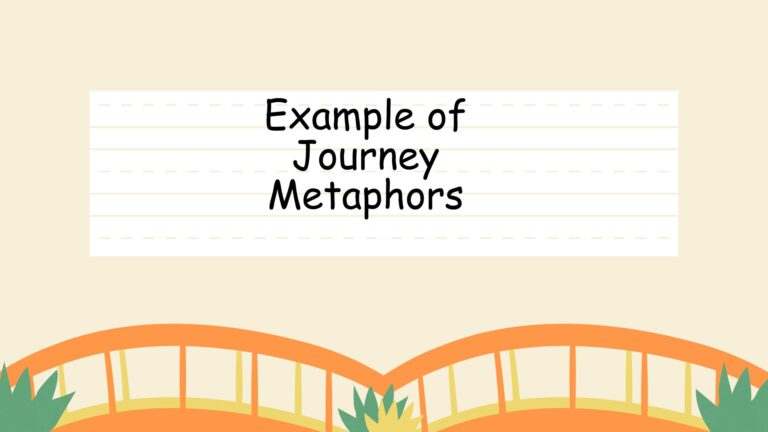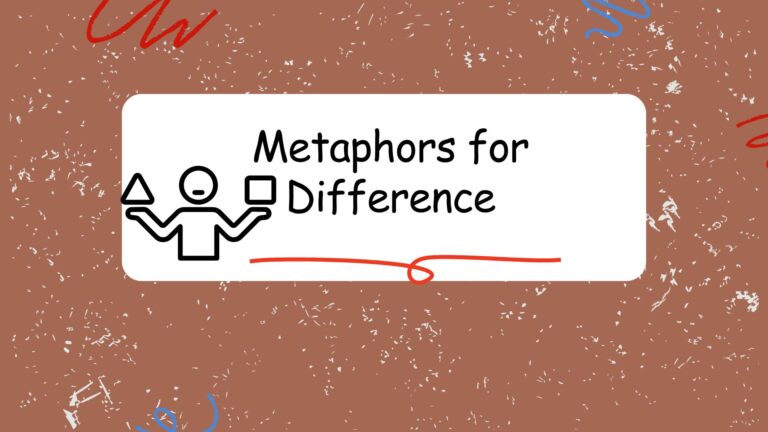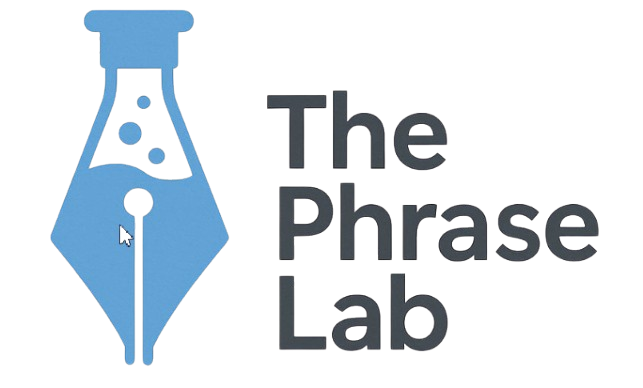
Metaphors for ‘Nice’: Enhancing Your English Vocabulary
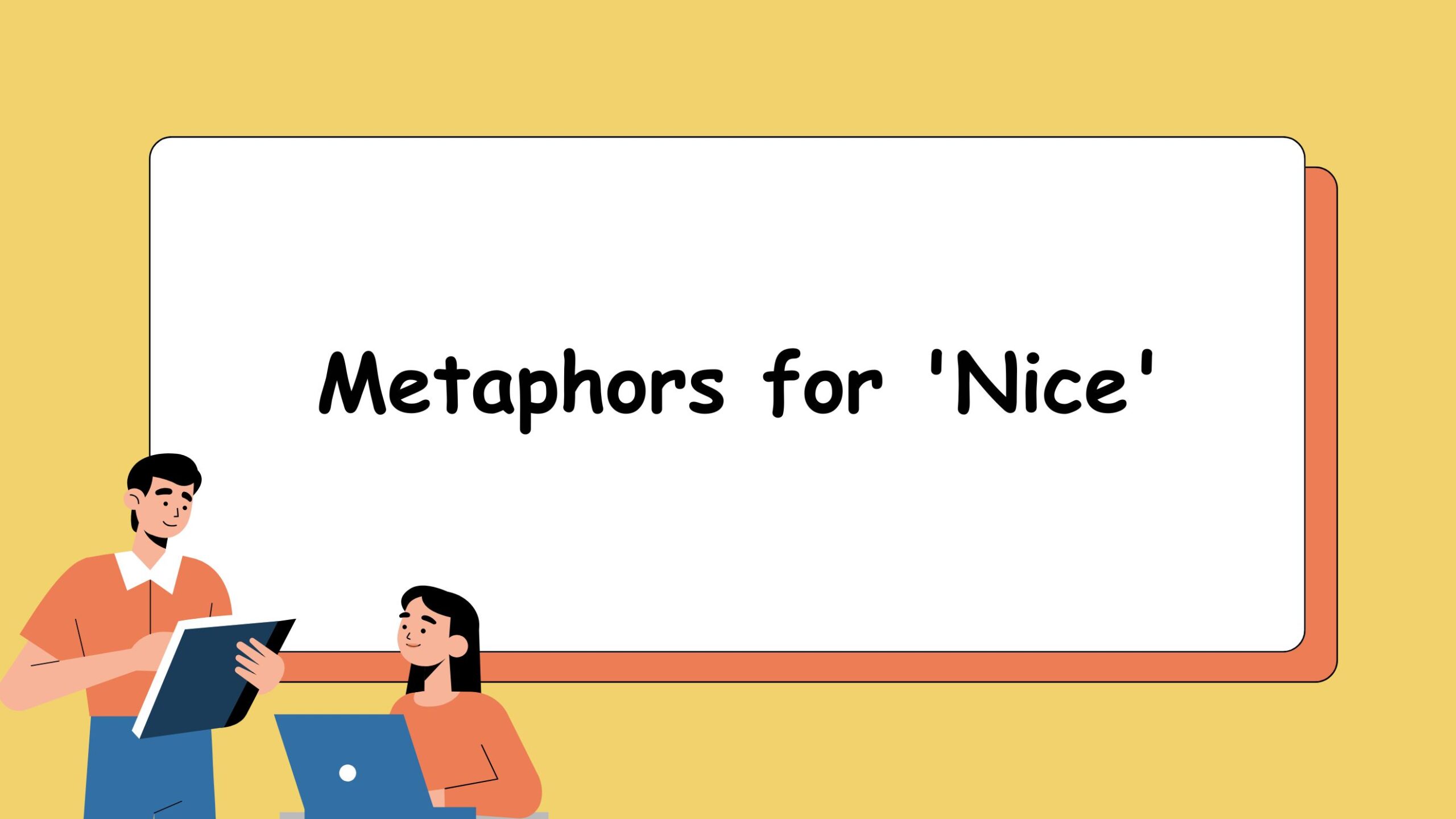
Understanding and using metaphors is crucial for mastering the nuances of the English language. While the word “nice” is commonly used, it often lacks the descriptive power needed to convey specific shades of meaning. This article explores various metaphors that can replace “nice,” offering a richer and more expressive vocabulary. This guide is perfect for English language learners, writers, and anyone looking to enhance their communication skills by moving beyond simplistic terms.
By the end of this article, you will be equipped with a plethora of metaphorical alternatives to “nice,” allowing you to articulate your thoughts and feelings with greater precision and flair. We will delve into different categories of metaphors, providing examples, usage rules, and practice exercises to solidify your understanding. Prepare to elevate your English vocabulary and expressiveness!
Table of Contents
- Introduction
- Definition of Metaphor and its Application to “Nice”
- Structural Breakdown of Metaphors
- Types of Metaphors for “Nice”
- Examples of Metaphors for “Nice”
- Usage Rules for Metaphors
- Common Mistakes When Using Metaphors
- Practice Exercises
- Advanced Topics in Metaphorical Usage
- Frequently Asked Questions
- Conclusion
Definition of Metaphor and its Application to “Nice”
A metaphor is a figure of speech that directly compares two unrelated things. Unlike similes, which use “like” or “as” to make a comparison, metaphors state that one thing is another. This creates a vivid and imaginative connection, allowing for a deeper understanding and appreciation of the subject at hand. In the context of replacing “nice,” metaphors enable us to express more nuanced shades of meaning, moving beyond the generic and often bland connotation of the word.
The function of a metaphor is to transfer qualities or characteristics from one concept to another. When we say someone is “a ray of sunshine,” we’re not literally saying they are a ray of sunshine. Instead, we’re using the positive qualities associated with sunshine (warmth, brightness, happiness) to describe the person’s personality. This adds depth and color to our language, making it more engaging and memorable.
Consider the word “nice.” It’s a general term that can mean anything from “pleasant” to “kind” to “attractive.” However, it lacks specificity. By using metaphors, we can pinpoint exactly what aspect of “nice” we want to emphasize. For instance, instead of saying “She is a nice person,” we could say “She has a heart of gold,” which specifically highlights her kindness and generosity. This is the power of metaphorical language – to transform simple statements into evocative descriptions.
Structural Breakdown of Metaphors
Understanding the structure of a metaphor can help you create and interpret them more effectively. A typical metaphor consists of two main elements: the tenor and the vehicle. The tenor is the subject being described, while the vehicle is the object or concept used to describe it. The vehicle lends its qualities to the tenor, creating the metaphorical meaning.
Let’s break down the example “He is a lion in battle.” Here, “he” is the tenor (the person being described), and “lion” is the vehicle (the object used to describe him). The qualities associated with a lion, such as courage, strength, and ferocity, are transferred to the person, implying that he is brave and powerful in battle.
The effectiveness of a metaphor depends on the strength and clarity of the connection between the tenor and the vehicle. A good metaphor should be both imaginative and understandable. The audience should be able to easily grasp the intended meaning and appreciate the comparison being made. If the connection is too obscure or far-fetched, the metaphor may fail to resonate and could even confuse the listener or reader.
Another crucial element is the ground – the shared characteristics between the tenor and the vehicle. In our “lion in battle” example, the ground is the shared quality of strength and fearlessness. Identifying the ground helps to clarify the meaning of the metaphor and ensures that the comparison is logical and relevant.
Types of Metaphors for “Nice”
When seeking alternatives to “nice,” it’s helpful to categorize metaphors based on the specific aspect of “nice” you want to convey. This section will explore different categories of metaphors, each focusing on a particular facet of the word.
Metaphors for Warmth and Kindness
These metaphors emphasize the caring and compassionate nature of a person or thing. They evoke feelings of comfort, empathy, and generosity, moving beyond the simple descriptor of “nice.”
Metaphors for Pleasantness and Agreeability
These metaphors focus on the enjoyable and harmonious qualities of a person or situation. They highlight the ease and comfort associated with being around someone or experiencing something, offering a more vivid alternative to “nice.”
Metaphors for Goodness and Morality
These metaphors underscore the ethical and virtuous nature of a person or action. They highlight integrity, honesty, and righteousness, providing a stronger and more meaningful alternative to “nice.”
Metaphors for Attractiveness and Beauty
These metaphors emphasize the appealing and aesthetically pleasing qualities of a person or object. They evoke feelings of admiration and delight, offering a more descriptive and evocative alternative to “nice.”
Metaphors for Skill and Expertise
These metaphors highlight the proficiency and competence of a person in a particular field. They convey a sense of mastery and accomplishment, providing a more specific and impressive alternative to “nice” when referring to someone’s abilities.
Examples of Metaphors for “Nice”
This section provides extensive examples of metaphors categorized by the specific aspect of “nice” they represent. Each category includes multiple examples to illustrate the diverse ways metaphors can be used to enhance your vocabulary.
Warmth and Kindness Examples
The following table provides examples of metaphors that can be used to describe someone who is warm and kind, replacing the generic term “nice.”
| Metaphor | Explanation | Example Sentence |
|---|---|---|
| A heart of gold | Implies genuine kindness and generosity. | She has a heart of gold; she’s always helping others. |
| A ray of sunshine | Suggests someone brings joy and positivity. | His smile is a ray of sunshine on a cloudy day. |
| An angel | Conveys purity, goodness, and selflessness. | She’s an angel for volunteering at the homeless shelter. |
| A warm blanket | Implies comfort, security, and affection. | Her words were like a warm blanket on a cold night. |
| A gentle breeze | Suggests a calming and soothing presence. | His presence is like a gentle breeze, always calming. |
| A comforting fire | Implies warmth, security, and a welcoming atmosphere. | Her laughter was like a comforting fire, drawing everyone closer. |
| A soft pillow | Suggests comfort, support, and a sense of ease. | He was a soft pillow for her to lean on during difficult times. |
| A helping hand | Conveys a willingness to assist and support others. | She’s always a helping hand to those in need. |
| A shoulder to cry on | Implies empathy, support, and a listening ear. | He was a shoulder to cry on when she lost her job. |
| A beacon of hope | Suggests guidance, inspiration, and optimism. | She’s a beacon of hope for the struggling community. |
| A wellspring of compassion | Implies a deep and abundant source of empathy. | He is a wellspring of compassion, always understanding others’ pain. |
| A gentle soul | Suggests kindness, tenderness, and a peaceful nature. | She is a gentle soul, never causing harm to anyone. |
| A fountain of kindness | Conveys an endless supply of generosity and goodwill. | He is a fountain of kindness, always ready to help. |
| A warm embrace | Implies comfort, affection, and acceptance. | Her words were like a warm embrace, comforting and reassuring. |
| A light in the darkness | Suggests guidance, hope, and a positive influence. | He was a light in the darkness for those who felt lost. |
| A balm to the soul | Implies soothing, healing, and comforting qualities. | Her music was a balm to the soul, calming and peaceful. |
| A ray of light | Suggests hope, positivity, and a bright outlook. | His optimism was a ray of light during the difficult project. |
| A kindred spirit | Conveys a deep connection, understanding, and shared values. | They were kindred spirits, sharing a passion for art and nature. |
| A gentle giant | Implies strength combined with kindness and compassion. | Despite his size, he was a gentle giant, always considerate of others. |
| A haven of peace | Suggests safety, tranquility, and a comforting environment. | Her home was a haven of peace, a place to escape the chaos of the world. |
| A cup of warm tea | Implies comfort, relaxation, and a sense of well-being. | Her presence was like a cup of warm tea, soothing and comforting. |
| A soft whisper | Suggests gentleness, kindness, and a calming presence. | Her advice was like a soft whisper, guiding him gently. |
Pleasantness and Agreeability Examples
The following table presents metaphors for describing someone or something that is pleasant and agreeable, offering alternatives to the word “nice.”
| Metaphor | Explanation | Example Sentence |
|---|---|---|
| A breath of fresh air | Suggests something new, refreshing, and enjoyable. | Her ideas were a breath of fresh air in the stale meeting. |
| A smooth melody | Implies harmony, ease, and a pleasant experience. | The conversation flowed like a smooth melody. |
| A summer breeze | Conveys lightness, warmth, and a delightful feeling. | Her laughter was like a summer breeze, light and carefree. |
| A sweet song | Suggests joy, beauty, and a pleasing sound. | His words were a sweet song to her ears. |
| A ray of hope | Implies optimism, positivity, and a bright outlook. | The new project was a ray of hope for the struggling company. |
| A clear sky | Suggests clarity, peace, and a lack of conflict. | Their relationship was like a clear sky, free from storms. |
| A gentle rain | Implies calmness, refreshment, and a soothing effect. | Her advice was like a gentle rain, nourishing and insightful. |
| A blooming garden | Conveys beauty, growth, and a vibrant atmosphere. | The party was like a blooming garden, full of life and color. |
| A warm welcome | Suggests hospitality, friendliness, and a sense of belonging. | She gave us a warm welcome upon our arrival. |
| A peaceful stream | Implies tranquility, calmness, and a soothing presence. | His voice was like a peaceful stream, calming and reassuring. |
| A gentle touch | Suggests kindness, care, and a delicate approach. | Her approach to the problem was like a gentle touch, resolving it with ease. |
| A silver lining | Conveys hope, optimism, and a positive aspect in a difficult situation. | Even in the midst of the crisis, there was a silver lining. |
| A smooth sail | Implies ease, success, and a lack of obstacles. | The project went like a smooth sail, without any major issues. |
| A pleasant dream | Suggests joy, happiness, and a delightful experience. | The vacation was like a pleasant dream, unforgettable and blissful. |
| A sunny disposition | Implies cheerfulness, optimism, and a positive attitude. | She has a sunny disposition, always smiling and cheerful. |
| A gentle whisper | Suggests calmness, kindness, and a soothing voice. | Her words were like a gentle whisper, comforting and reassuring. |
| A sweet melody | Implies harmony, beauty, and a pleasing sound. | The music was like a sweet melody, enchanting and delightful. |
| A soft breeze | Conveys lightness, gentleness, and a refreshing feeling. | Her presence was like a soft breeze, calming and pleasant. |
| A warm glow | Suggests happiness, contentment, and a positive atmosphere. | The room was filled with a warm glow of friendship and laughter. |
| A golden opportunity | Implies a chance for success, advancement, and positivity. | The job offer was a golden opportunity, too good to pass up. |
| A gentle invitation | Suggests kindness, warmth, and a welcoming approach. | Her request was a gentle invitation, not a demanding order. |
| A sweet serenade | Implies beauty, charm, and a delightful performance. | The birds’ singing was like a sweet serenade, filling the morning air. |
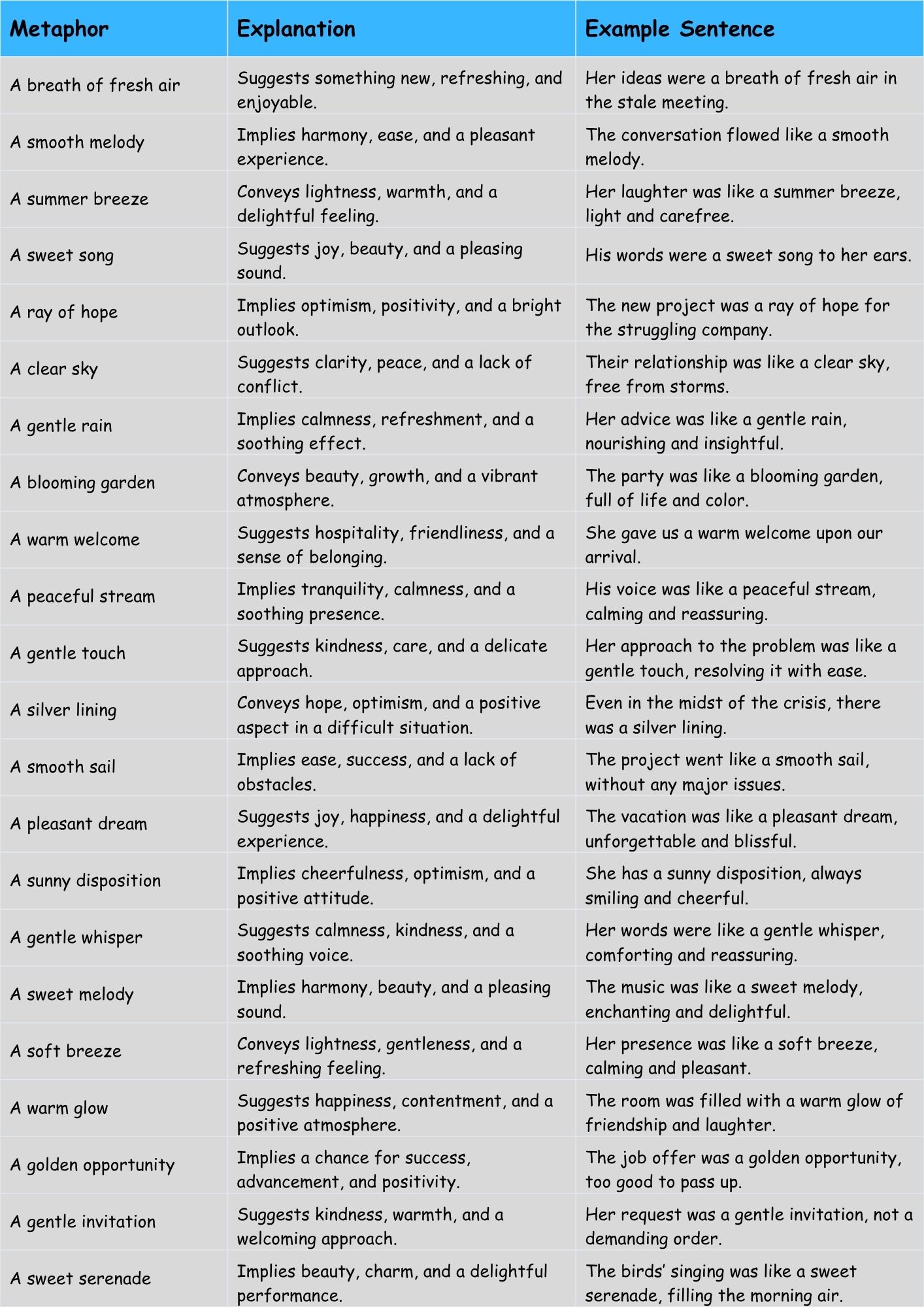
Goodness and Morality Examples
The following table provides examples of metaphors to describe moral goodness, replacing simple uses of “nice.”
| Metaphor | Explanation | Example Sentence |
|---|---|---|
| A moral compass | Implies a strong sense of right and wrong. | He is a moral compass for the entire community. |
| A shining example | Suggests someone who embodies virtue and integrity. | She is a shining example of honesty and hard work. |
| A pillar of strength | Conveys reliability, support, and moral fortitude. | He was a pillar of strength for his family during the crisis. |
| A beacon of truth | Suggests honesty, integrity, and unwavering principles. | Her words were a beacon of truth in a sea of lies. |
| A virtuous soul | Implies purity, goodness, and moral excellence. | She is a virtuous soul, always striving to do what is right. |
| A heart of justice | Implies fairness, impartiality, and a commitment to righteousness. | He has a heart of justice, always fighting for what is fair. |
| A guardian angel | Suggests protection, guidance, and unwavering support. | She was like a guardian angel, watching over him and keeping him safe. |
| A voice of reason | Conveys wisdom, rationality, and sound judgment. | In the midst of the chaos, he was a voice of reason. |
| A true north | Suggests guidance, direction, and unwavering principles. | His values were like a true north, guiding his decisions. |
| A light in the dark | Implies hope, guidance, and a positive influence. | She was a light in the dark for those who felt lost. |
| A foundation of integrity | Suggests honesty, trustworthiness, and unwavering principles. | His word was a foundation of integrity, always reliable and true. |
| A conscience clear | Conveys honesty, guiltlessness, and moral purity. | He lived with a conscience clear, knowing he had done no wrong. |
| A keeper of the faith | Implies loyalty, devotion, and unwavering belief. | She was a keeper of the faith, always upholding her values. |
| A sword of truth | Suggests honesty, justice, and a commitment to righteousness. | His words were like a sword of truth, cutting through the lies. |
| A path of righteousness | Implies moral uprightness, virtue, and ethical conduct. | He walked a path of righteousness, always striving to do what is right. |
| A shield of honor | Suggests protection, integrity, and unwavering principles. | His reputation was like a shield of honor, protecting him from slander. |
| A rock of stability | Implies reliability, dependability, and unwavering support. | She was a rock of stability for her family, always there in times of need. |
| A gold standard | Suggests excellence, high standards, and moral superiority. | His behavior was a gold standard of ethical conduct. |
| A tower of strength | Implies resilience, fortitude, and unwavering support. | She was a tower of strength, supporting her community through hard times. |
Attractiveness and Beauty Examples
The following table provides metaphors for describing someone who is beautiful or attractive, offering alternatives to using just “nice.”
| Metaphor | Explanation | Example Sentence |
|---|---|---|
| A radiant star | Implies brightness, beauty, and captivating presence. | She was a radiant star on the red carpet. |
| A blooming flower | Suggests beauty, freshness, and vibrant allure. | She looked like a blooming flower in her spring dress. |
| A work of art | Conveys exceptional beauty, artistry, and perfection. | Her face was a work of art, perfectly sculpted and flawless. |
| A vision of loveliness | Suggests exquisite beauty, charm, and grace. | She was a vision of loveliness in her wedding gown. |
| A captivating melody | Implies beauty, harmony, and an enchanting presence. | Her voice was like a captivating melody, drawing everyone in. |
| A summer’s day | Suggests warmth, beauty, and radiant charm. | Her smile was like a summer’s day, bright and cheerful. |
| A flawless diamond | Implies perfection, brilliance, and unmatched beauty. | Her eyes were like a flawless diamond, sparkling and captivating. |
| A graceful swan | Conveys elegance, beauty, and effortless charm. | She moved like a graceful swan, gliding across the room. |
| An enchanting dream | Suggests beauty, wonder, and a captivating experience. | The evening was like an enchanting dream, magical and unforgettable. |
| A breathtaking view | Implies stunning beauty, grandeur, and awe-inspiring presence. | She was a breathtaking view in her elegant dress. |
| A golden sunset | Suggests beauty, warmth, and a radiant glow. | Her hair was like a golden sunset, shimmering and beautiful. |
| A rare gem | Conveys uniqueness, beauty, and exceptional value. | She was a rare gem, unlike anyone he had ever met. |
| A perfect rose | Implies beauty, elegance, and flawless perfection. | Her skin was like a perfect rose, soft and radiant. |
| A stunning masterpiece | Suggests exceptional beauty, artistry, and a remarkable creation. | The painting was a stunning masterpiece, captivating and inspiring. |
| A vision of elegance | Implies grace, beauty, and refined sophistication. | She was a vision of elegance in her classic gown. |
| A delicate flower | Suggests beauty, fragility, and refined delicacy. | Her touch was as light as a delicate flower. |
| A shimmering pearl | Implies beauty, purity, and radiant glow. | Her smile was like a shimmering pearl, radiant and captivating. |
| An ethereal beauty | Conveys otherworldly beauty, grace, and enchanting charm. | She possessed an ethereal beauty, almost unreal. |
| A captivating sight | Suggests beauty, allure, and an enchanting presence. | The fireworks were a captivating sight, lighting up the night sky. |
Skill and Expertise Examples
The following table offers metaphors to describe skill and expertise, replacing bland uses of “nice” when referring to someone’s abilities.
| Metaphor | Explanation | Example Sentence |
|---|---|---|
| A master craftsman | Implies exceptional skill, artistry, and expertise. | He is a master craftsman when it comes to woodworking. |
| A seasoned veteran | Suggests extensive experience, skill, and knowledge. | She is a seasoned veteran in the field of medicine. |
| A virtuoso performer | Conveys exceptional talent, skill, and artistry. | He is a virtuoso performer on the piano, captivating audiences. |
| A skilled artisan | Suggests craftsmanship, creativity, and expertise. | She is a skilled artisan, creating beautiful pottery. |
| A seasoned professional | Implies experience, skill, and competence in a field. | He is a seasoned professional in the world of finance. |
| A sharp tool | Suggests precision, skill, and effectiveness. | Her mind is like a sharp tool, able to solve complex problems. |
| A well-oiled machine | Implies efficiency, skill, and smooth operation. | The team worked like a well-oiled machine, completing the project on time. |
| A guiding hand | Conveys skill, expertise, and supportive guidance. | He was a guiding hand for the young entrepreneurs. |
| A wizard with words | Suggests skill, eloquence, and persuasive communication. | She is a wizard with words, able to captivate any audience. |
| A master strategist | Implies skill, planning, and tactical expertise. | He is a master strategist, always thinking several steps ahead. |
| A steady hand | Suggests skill, precision, and calm control. | He has a steady hand when performing surgery. |
| A fountain of knowledge | Conveys extensive knowledge, expertise, and wisdom. | She is a fountain of knowledge on the subject of history. |
| A natural talent | Implies innate skill, ability, and effortless expertise. | He is a natural talent when it comes to playing the guitar. |
| An expert navigator | Suggests skill, precision, and the ability to guide. | She is an expert navigator in the world of business. |
| A seasoned pilot | Implies experience, skill, and expertise in a field. | He is a seasoned pilot in the world of aviation. |
| A keen eye | Suggests skill, precision, and attention to detail. | She has a keen eye for design. |
| A gifted artist | Implies skill, creativity, and artistic talent. | He is a gifted artist, creating masterpieces on canvas. |
| A skilled surgeon | Conveys expertise, precision, and medical skill. | She is a skilled surgeon, saving lives every day. |
| A brain trust | Suggests a group with skill and expertise. | The company hired a brain trust to solve the challenging problem. |
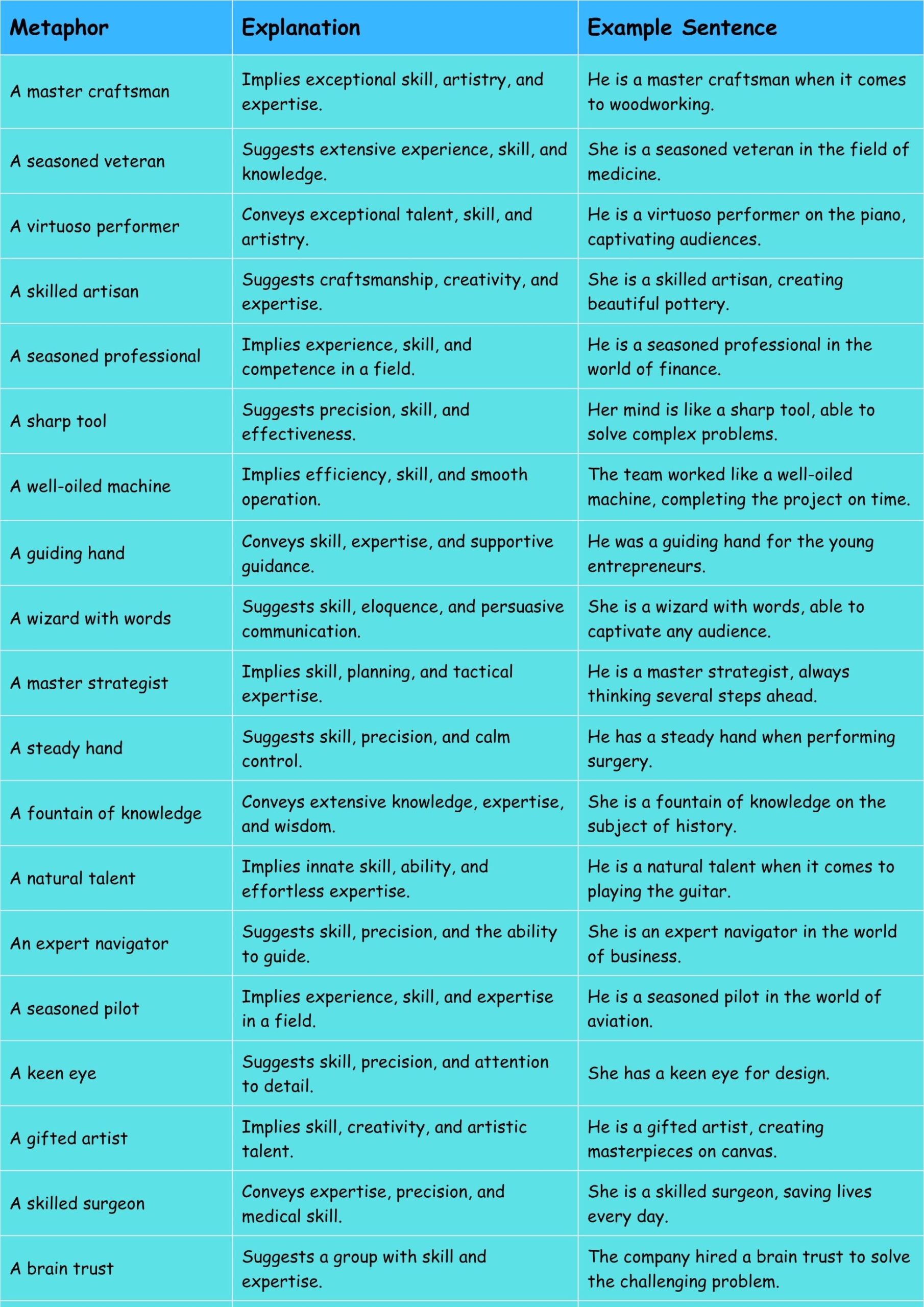
Usage Rules for Metaphors
While metaphors can greatly enrich your language, it’s important to use them correctly to avoid confusion or misinterpretation. Here are some key usage rules to keep in mind:
- Clarity: Ensure that the connection between the tenor and the vehicle is clear and understandable. Avoid metaphors that are too obscure or far-fetched.
- Relevance: Choose metaphors that are relevant to the context and the subject being described. The comparison should be logical and meaningful.
- Originality: Strive for originality in your metaphors. Overused or clichéd metaphors can lose their impact and become tiresome.
- Consistency: Maintain consistency within a metaphor. Avoid mixing metaphors that create conflicting or nonsensical images.
- Appropriateness: Consider the audience and the tone of the communication. Use metaphors that are appropriate for the situation and the intended audience.
It’s also crucial to avoid mixed metaphors, which occur when two or more incompatible metaphors are combined in a single statement. For example, “Let’s nip it in the bud before it snowballs” combines two unrelated images (nipping a bud and a snowball rolling downhill), resulting in a confusing and nonsensical statement.
Another important consideration is the extended metaphor, which is a metaphor that is developed over several lines or paragraphs. When using an extended metaphor, it’s essential to maintain consistency and ensure that all aspects of the comparison are logical and relevant.
Common Mistakes When Using Metaphors
Even experienced writers and speakers can make mistakes when using metaphors. Being aware of these common errors can help you avoid them and use metaphors more effectively.
1. Clichéd Metaphors: Using overused metaphors that have lost their impact.
* Incorrect: “He was as brave as a lion.”
* Correct: “He faced the challenge with unwavering courage, like a seasoned warrior.”
2. Mixed Metaphors: Combining two or more incompatible metaphors.
* Incorrect: “We need to iron out the wrinkles and then steer the ship home.”
* Correct: “We need to resolve the issues and then guide the project to completion.”
3. Unclear Metaphors: Using metaphors that are difficult to understand or interpret.
* Incorrect: “His argument was a purple banana.”
* Correct: “His argument was illogical and nonsensical.”
4. Inappropriate Metaphors: Using metaphors that are not suitable for the context or the audience.
* Incorrect: “The surgery was a walk in the park.” (when referring to a serious operation)
* Correct: “The surgery was a delicate procedure requiring precision and expertise.”
5. Overusing Metaphors: Using too many metaphors in a short space, which can become overwhelming and distracting.
* Incorrect: “The project was a rollercoaster, a stormy sea, and a mountain to climb.”
* Correct: “The project was a challenging journey with many ups and downs.”
Practice Exercises
Test your understanding of metaphors with these practice exercises. Choose the best metaphorical alternative to “nice” in each sentence.
| Question | Options | Answer |
|---|---|---|
| 1. She is a ______ person, always willing to help. | a) nice b) heart of gold c) okay d) average | b) heart of gold |
| 2. The weather today is ______. | a) nice b) okay c) a breath of fresh air d) normal | c) a breath of fresh air |
| 3. He has a ______ personality. | a) nice b) good c) sunny disposition d) fine | c) sunny disposition |
| 4. Her singing voice is ______. | a) nice b) okay c) a captivating melody d) standard | c) a captivating melody |
| 5. He is a ______ lawyer. | a) nice b) good c) sharp tool d) decent | c) sharp tool |
| 6. She is a ______ influence on her friends. | a) nice b) okay c) beacon of truth d) standard | c) beacon of truth |
| 7. The party was ______. | a) nice b) good c) a blooming garden d) fine | c) a blooming garden |
| 8. His advice was ______. | a) nice b) helpful c) a gentle rain d) useful | c) a gentle rain |
| 9. She is a ______ dancer. | a) nice b) okay c) graceful swan d) adequate | c) graceful swan |
| 10. He is a ______ leader. | a) nice b) capable c) guiding hand d) fine | c) guiding hand |
Advanced Topics in Metaphorical Usage
Once you’ve mastered the basics of using metaphors, you can explore more advanced techniques to further enhance your writing and speaking. These include:
- Creating Original Metaphors: Instead of relying on existing metaphors, try to create your own by finding unique connections between seemingly unrelated things.
- Using Metaphors Subtly: Integrate metaphors seamlessly into your language without making them too obvious or forced.
- Layering Metaphors: Combine multiple metaphors to create richer and more complex imagery.
- Employing Metaphors in Storytelling: Use metaphors to enhance the emotional impact of your stories and create deeper connections with your audience.
- Adapting Metaphors to Different Contexts: Adjust your metaphors to suit the specific context and audience, ensuring that they are appropriate and effective.
Experiment with different types of metaphors and pay attention to how they affect the tone and impact of your message. The more you practice, the more skilled you will become at using metaphors to express yourself in a vivid and compelling way.
Frequently Asked Questions
What is the difference between a metaphor and a simile?
A metaphor directly compares two unrelated things by stating that one thing is another, while a simile uses “like” or “as” to make a comparison. For example, “He is a lion” (metaphor) vs. “He is as brave as a lion” (simile).
How can I avoid using clichéd metaphors?
Strive for originality by finding unique connections between things and crafting your own metaphors. Read widely and pay attention to how other writers use metaphors effectively.
What should I do if I accidentally use a mixed metaphor?
Revise your sentence to eliminate the conflicting images and create a clear, consistent comparison. Focus on conveying a single, coherent idea.
Are there any situations where I should avoid using metaphors?
In highly technical or scientific writing, where precision and clarity are paramount, it’s best to avoid metaphors. Also, be mindful of your audience and avoid metaphors that may be confusing or offensive.
How can I improve my ability to understand and interpret metaphors?
Read widely, pay attention to the context in which metaphors are used, and practice identifying the tenor, vehicle, and ground of each metaphor. The more you engage with metaphorical language, the better you will become at understanding it.
Conclusion
Mastering the art of using metaphors can significantly enhance your English vocabulary and communication skills. By moving beyond simple descriptors like “nice” and embracing more vivid and imaginative language, you can express yourself with greater precision and impact. Remember to use metaphors thoughtfully and purposefully, always considering the context, audience, and intended message. With practice and attention to detail, you can unlock the power of metaphorical language and elevate your writing and speaking to new heights.

